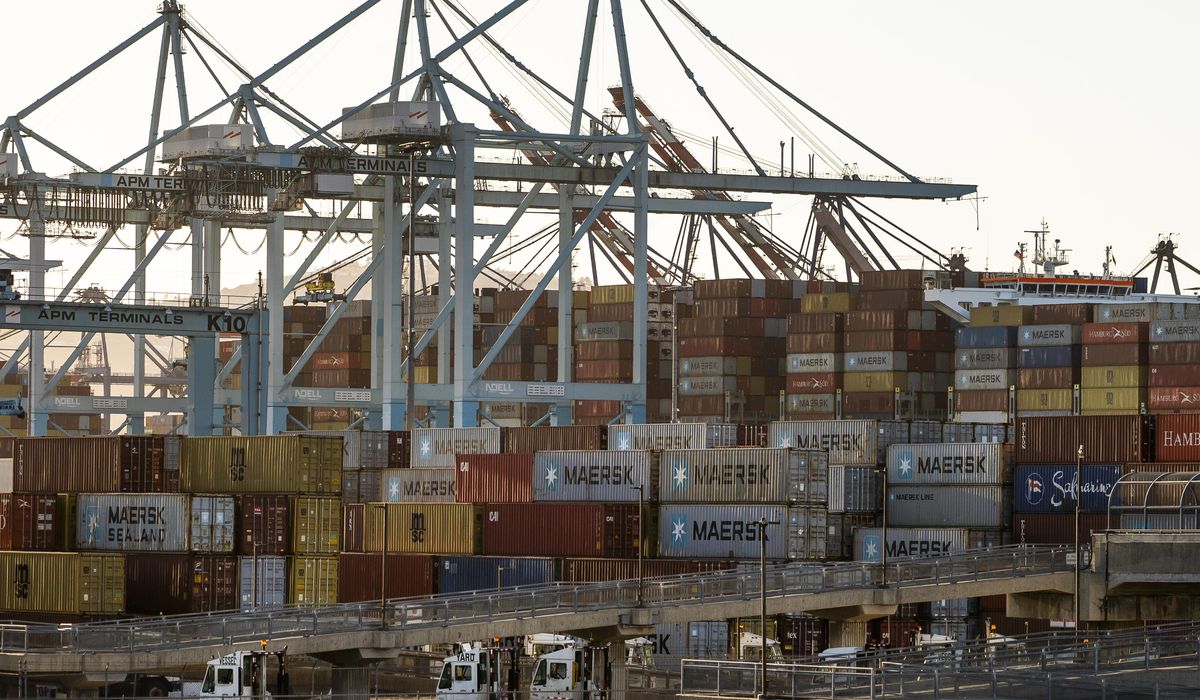
The throng of container ships anchored off the coast of Southern California grew by 43% since President Biden’s announcement a month ago that the ports there would start working around the clock and ease supply chain woes.
A record 83 cargo ships sat off the coast Friday awaiting offload at the Ports of Los Angeles and Long Beach, according to data from the Marine Exchange of Southern California. That’s 25 more than the 58 container ships in the backup than when Mr. Biden made his announcement in mid-October.
When making the announcement, he said the longer hours at the ports would help keep the store shelves stocked for holiday shopping.
“Today we have some good news: We’re going to help speed up the delivery of goods all across America,” he said when announcing 24-hour port operations on Oct. 13. He also said the ports were just part of the supply chain problem but vowed to make progress sooner rather than later.
The White House did not respond to questions about the lack of progress at the ports.
Mr. Biden on Monday signed into law a $1.2 trillion bipartisan infrastructure program that includes extensive upgrades to America’s highways, bridges, public transportation and ports.
He has promised the port projects will alleviate the supply chain hangups, though new construction and dredging are expected to take years to complete.
“My message to the American people is this: America is moving again, and your life is going to change for the better,” Mr. Biden said at the signing ceremony.
Meanwhile, snag in moving products across the country puts the pinch on farmers, automakers, retailers and ultimately consumers.
Port officials say the expanded working hours help and they are on track to move a record volume of goods in 2021. They blame the persistent backlog on kinks upstream in the supply chain.
Marine Exchange’s Executive Director J. Kipling Louttit said September through November are always busy months for the ports, which receive 40% of the nation’s containerized imports, as stores stock up for the holidays, but this year’s backup is unprecedented.
“If you go back a year, the normal number of container ships at anchor pre-COVID is zero to one,” Mr. Louttit said.
The American Trucking Associations estimated last month that the industry is short a record of 80,000 drivers. And despite the ports working more hours, most warehouses have not expanded their hours to receive the goods.
“The cargo has nowhere to go,” Port of Los Angeles Executive Director Gene Seroka told CBS’ “60 Minutes” in an interview that aired Sunday. “We’ve gotta get a workforce in the warehouses and the trucking industry that are complementary to all this cargo that is — that’s coming in right now.”
More than 76,000 containers have piled up onshore at the Port of Los Angeles, threatening to grind operations to a halt as the ports run out of space. More than 25% of the containers have been onshore at the port for 13 days or longer.
To address the buildup of containers, the Ports of Los Angeles and Long Beach announced a plan to begin charging a fee on containers that dwell for more than six days. The fines, however, potentially add to the already skyrocketing costs to bring in products from overseas.
The fee was scheduled to go into effect Monday, but the ports announced at the last minute that they had “postponed consideration” of the penalty for an additional week.
Last week, the White House’s task force said that the fee threat was beginning to have an impact. They said the number of containers remaining on the docks nine days or more had fallen by more than 20%.
Business leaders worry that their supply chain headaches aren’t going away anytime soon.
“I expect this to continue into 2022, for the entire 2022,” Luca Zaramella, the chief financial officer of Chicago-based Mondelez International, told Yahoo Finance. “I think the holiday season ahead of us will put even more strains on global supply chains.”
Mr. Zaramella said the bottlenecks in the supply chains could drive further inflation globally.
“I think that we might see some things changing maybe into 2023, but quite honestly 2022, I believe, is going to be a tough situation for global supply chains,” he said.
Correction: A previous version of this story incorrectly referred to Mr. Zaramella in the second reference. Also, there was a garbled paragraph that was made clearer in the updated version.








